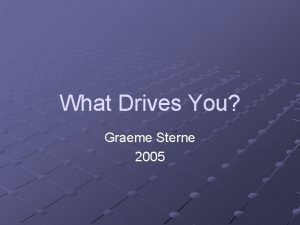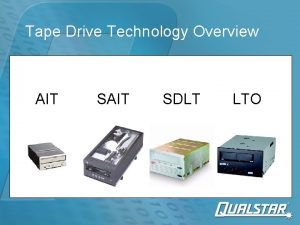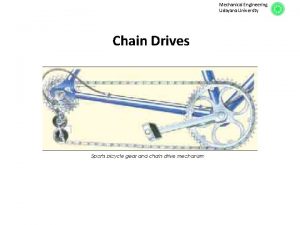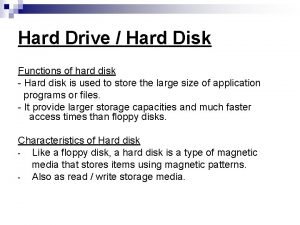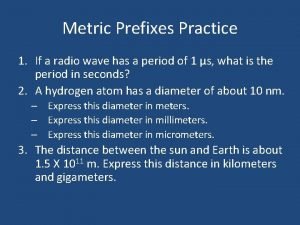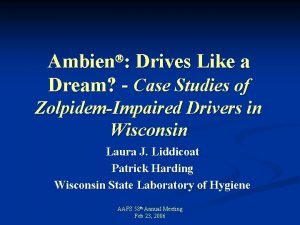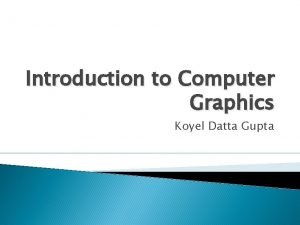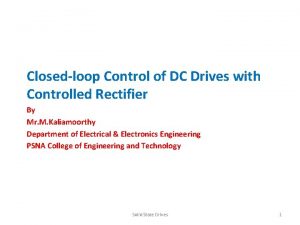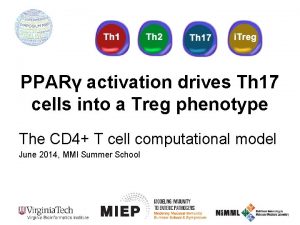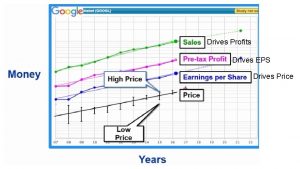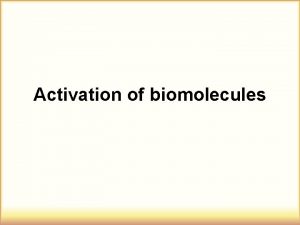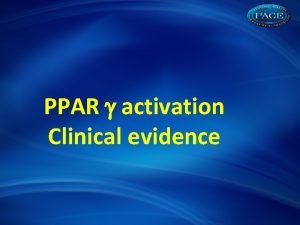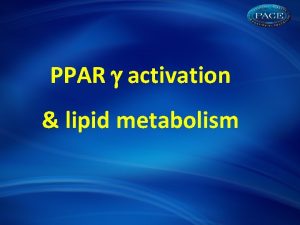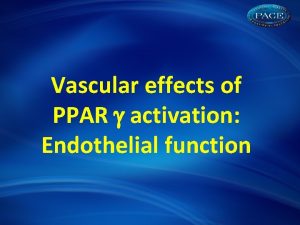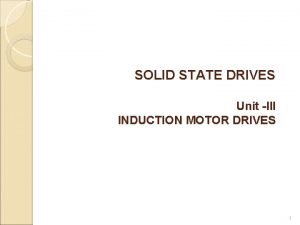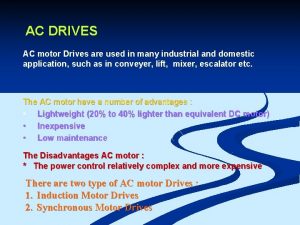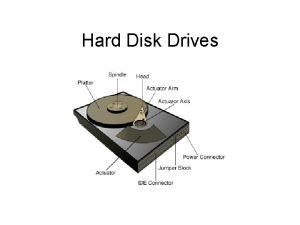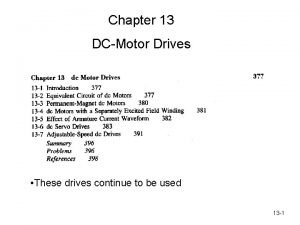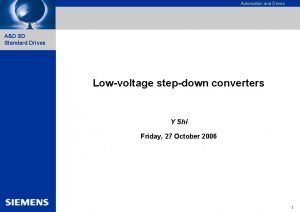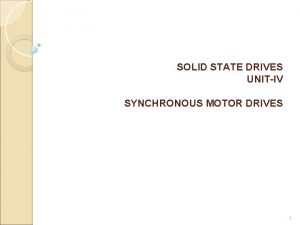PPAR activation drives Th 17 cells into a































- Slides: 31

PPARγ activation drives Th 17 cells into a Treg phenotype The CD 4+ T cell computational model June 2014, MMI Summer School

What will this presentation show you? Refinement of the model with new generated data In vivo/vitro validation Hypothesis testing In silico experimentation Prediction generation MODELING APPROACH Literature mining & in-house generated data Creation of the network Parameter estimation and ODEs adjustments

Outline • • • Background introduction The CD 4+ T cell computational model Model calibration: Parameter estimation process In silico experimentation Experimental validation Conclusions

Introduction The immune system is mainly characterized by TWO different responses: 1. The INNATE immune response NON-SPECIFIC: Macrophages, dendritic cells, neutrophils, epithelial cells 2. The ADAPTIVE immune response SPECIFIC: CD 8+ T cells, B cells, CD 4+ T cells orchestrate adaptive and innate immune response by secretion of cytokines and other soluble factors in the environment

Introduction Cytokine signaling TCR signal Co-stimulatory signal

Introduction

The CD 4+ T cell computational model Th 1 Th 2 i. Treg Th 17

The CD 4+ T cell computational model 93 species & 52 reactions A e. IFNg + IFNg. R k 1 K 1, k 2, … , kn B IFNg-IFNg. R We need to adjust the dynamics of the model

Model Calibration Experimental data & In-House generated Calibration database COmplex PAthway SImulator Fitting algorithm in COPASI

Quality Control

PPARγ The peroxisome proliferator activated receptor gamma § Loss of PPARγ results in enhanced Ag-specific proliferation and overproduction of IFN-γ. (Raquel Hontecillas and Josep Bassaganya-Riera. Journal of Immunology. 2007) § PPAR γ inhibits Th 1 and Th 17 responses in experimental allergic (Kanakasabi et al. Immunology. 2009) encephalomyelitis § PPARγ inhibits TGFβ/IL-6 -induced expression of RORγ-t in CD 4+ T cells. (Klotz et al. Journal of Experimental Medicine. 2009) § PPARγ promotes together with TGFβ the switching from CD 4+ CD 25 - T cells into functional FOXP 3+ regulatory T cells. (Lei et al. Journal of Immunology. 2010)

In silico experimentation GOAL: Check whether activation of PPARγ influences differentiation and state in either a naïve or differentiated T cell IL-6 + TGFβ Parameter SCAN: We are scanning the concentration of PPARγ, from 0 mol/l to 0. 5 mol/l to determine the impact on the dynamics of the system

In silico experimentation GOAL: Check whether activation of PPARγ influences differentiation and state in either a naïve or differentiated T cell TIME-COURSE: We differentiate to Th 17 and t=250 h we activate PPARγ in the system.

In silico experimentation GOAL: Check whether activation of PPARγ influences differentiation and state in either a naïve or differentiated T cell TIME-COURSE & Parameter scan together: We differentiate to Th 17 and we run several time-courses together, each one with an increased concentration of PPARγ

In silico experimentation GOAL: Check whether activation of PPARγ influences differentiation and state in either a naïve or differentiated T cell In silico PPARγ KNOCK-OUT: We are impairing the ability of PPARγ to exert its functions in the CD 4+ T cell system. We are then differentiating the system to Th 17 and Treg.

In silico experimentation PREDICTIONS 1. Activation of PPARγ in a Th 17 cell downregulates RORγt and IL-17 A and upregulates FOXP 3 PPARγ triggers a change in phenotype from Th 17 to Treg 2. The loss of PPARγ impairs the ability of Tregs to express FOXP 3 and accentuates the expression of RORγt and IL-17 in Th 17 PPARγ modulates Th 17 and i. Treg fates and functions 3. Increasing concentrations of PPARγ led to increasing concentrations of FOXP 3 and decreasing concentrations of RORγt and IL-17 in Th 17 PPARγ can exert its effects in a dose-dependent manner

Main hypothesis PPARγ activation drives Th 17 cells into a i. Treg phenotype

In vitro experimentation Pioglitazone is a PPARγ agonist: It activates PPARγ! Wild-type PPARγ null Isolated naïve CD 4+ T cells Culture cells under Th 17 polarizing conditions for 60 h Assess RORγt and IL-17 levels using flow cytometry Add increasing concentrations of pioglitazone to the culture

In vitro experimentation (Computational prediction)

In vitro experimentation

In vivo experimentation SCID: Immunosuppresed mice -They do not have any functional T cells- DISEASE ACTIVITY INDEX

In vivo experimentation HISTOPATHOLOGY

In vivo experimentation FLOW CYTOMETRY ANALYSIS

In vivo experimentation (2)

In vivo experimentation (2) Disease activity index Weight loss

In vivo experimentation (2) HISTOPATHOLOGY

In vivo experimentation Flow cytometry ANALYSIS

In vivo/vitro validation 1. Activation of PPARγ in a Th 17 cell downregulates RORγt and IL-17 A and upregulates FOXP 3 Validated with pharmacological activation of PPARγ in vivo, and in vitro studies 2. The loss of PPARγ impairs the ability of Tregs to express FOXP 3 and accentuates the expression of RORγt and IL-17 in Th 17 Validated with PPARγ KO experiments in vivo and in vitro 3. Increasing concentrations of PPARγ led to increasing concentrations of FOXP 3 and decreasing concentrations of RORγt and IL-17 in Th 17 Validated with in vitro studies performing increasing concentrations of pioglitazone

What will this presentation show you? Refinement of the model with new generated data In vivo/vitro validation Hypothesis testing In silico experimentation Prediction generation MODELING APPROACH Literature mining & in-house generated data Creation of the network Parameter estimation and ODEs adjustments

Conclusions a. We succesfully created a computational and mathematical model of the CD 4+ T cell differentiation b. Computational modeling studies predicted that the PPARγ modulates the balance between Th 17 and i. Treg cells c. Our in vitro results support the dose-dependent effect and in vivo findings further demonstrate that pioglitazone treatment favors a switch from Th 17 to i. Treg d. Results of adoptive transfer studies indicate that activation of PPARγ by oral pioglitazone treatment favors a switch from Th 17 to i. Treg in MLN and colonic e. PPARγ is implicated in the modulation of CD 4+ T cell plasticity in vivo. f. The loss of PPARγ favors Th 17 differentiation and reduces the conversion of CD 4+FOXP 3+ T cells from IL-17 A-producing Th 17 cells in vivo. g. This is broadly applicable to the development of immune therapeutics for infectious, allergic and immune-mediated diseases.

Questions? Thanks!
 Activation tree example
Activation tree example Prokaryotes vs eukaryotes venn diagram
Prokaryotes vs eukaryotes venn diagram Medullary portion of collecting duct
Medullary portion of collecting duct What animals have prokaryotic cells
What animals have prokaryotic cells Red blood cells and white blood cells difference
Red blood cells and white blood cells difference The organelle trail
The organelle trail Thyroid parafollicular cells
Thyroid parafollicular cells Chapter 8 cellular reproduction cells from cells
Chapter 8 cellular reproduction cells from cells Is a red blood cell prokaryotic or eukaryotic
Is a red blood cell prokaryotic or eukaryotic Prokaryotic vs eukaryotic cells
Prokaryotic vs eukaryotic cells Masses of cells form and steal nutrients from healthy cells
Masses of cells form and steal nutrients from healthy cells Gamete vs somatic cell
Gamete vs somatic cell Cell substance
Cell substance Plant and animal cell venn diagram
Plant and animal cell venn diagram Paranasal sinuses development
Paranasal sinuses development Pseudostratified vs simple columnar
Pseudostratified vs simple columnar Why dna is more stable than rna?
Why dna is more stable than rna? What drives you in life
What drives you in life Ait tape
Ait tape Roller chain
Roller chain Hard drive uses and functions
Hard drive uses and functions Marissa's car accelerates uniformly
Marissa's car accelerates uniformly What drives people to explore?
What drives people to explore? Drives like a dream
Drives like a dream Organizing shared drives
Organizing shared drives What drives weather
What drives weather Simpson drives his car with an average velocity of 48
Simpson drives his car with an average velocity of 48 What drives behavior
What drives behavior What drives computer graphics
What drives computer graphics Closed loop control of dc drives
Closed loop control of dc drives Mechanical drives and lifting machines n2
Mechanical drives and lifting machines n2 Bardac drives
Bardac drives

















